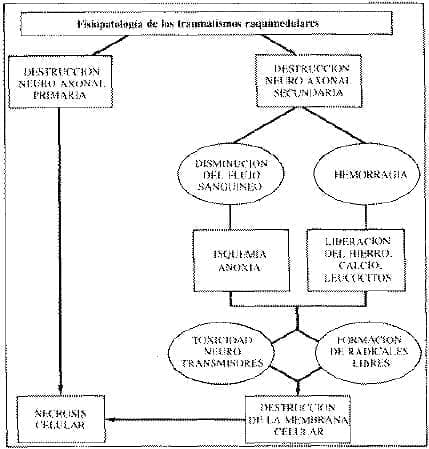Con el desarrollo del conocimiento de las acciones tóxicas de algunos aminoácidos neurotransmisores excitadores como el Aspartato y el Glutamato, se han desarrollado sustancias antagonistas como el N-metil-D-Aspartato (NMDA) los cuales limitan el daño tisular causado por la isquemia y por las alteraciones bioquímicas subsecuentes.
Ensayos en el modelo experimental de traumatismo medular en ratas con dosis de un miligramo por kg, mostraron que un 50% de los animales recuperaron la capacidad ambulatoria en contraste con el 25% de los controles. (Faden y col.. Gómez-Pinilla y coL).
Otras modalidades que se han utilizado incluyen el empleo de campos eléctricos, oxígeno hiperbárico, bloqueadores de los canales del calcio. Laser de baja potencia. etc.
Todos estos conceptos aumentan la esperanza de poder contribuir a obtener los medios para prevenir la lesión medular secundaria al traumatismo y buscar el camino para encontrar la curación de la parálisis producida por los traumatismos raquimedulares.
Resumen
Los traumatismos raquimedulares han sido conocidos desde la más remota antigüedad y cuando la lesión es completa, todavía no hay tratamiento curativo. Los avances de los últimos años en el conocimiento de los mecanismos fisiopatológicos responsables de las lesiones medulares han abierto la puerta para buscar la solución a este problema que afecta a un gran volumen de la población joven y representa una grave pérdida económica y social para las víctimas de los accidentes de diferentes clases. En esta revisión se describen los conocimientos actuales del problema y se vislumbran posibles vías terapéuticas para utilizar métodos farmacológicos en la escena del accidente con el objeto de prevenir lesiones ulteriores.

Agradecimiento
El ingeniero J. R. Gómez hizo el diseño gráfico de la figura. La señora Isabel Caballero y el personal de la Biblioteca Calder. De la Universidad de Miami. Contribuyeron a la investigación bibliográfica.
Bibliografía
- ALLEN AR. Surgery of experimental lesion of spinal cord equivalent to crush injury of fracture dislocation of spinalcolumn. Jama. 1911;62:878-880.
- ANDERSON OK, OEMEDIUK P, SAUNDERS RO, et al. Spinal cord injury and protection. (Review) Ann Emerg Med.1985; 14:816-821.
- ANDERSON OK, BRAUGHIER JM, HALL EO, et al. Effects of treatment with U-74006F 00. neurological outcome following experimental spinal cord injury J Neurosurg1988;69:562-567.
- ARIAS MJ, Treatment of Experimental spinal cord injury with TRH, Naloxone and dexamethasone. Surg Neuro/1987;28:33- 338.
- BLACK P, MARKOWITZ RS, COOPERV, et al. Models ofSpinal Cord lnjury: Part 1. Static Load technique. Neurosurgery.1986;19:752-762.
- BLACK P, MARKOWITZ RS, KELLERS, et al. Naloxone and experimental cord injury: Part 1. High dose administration in a static load compression model, Neurosurgery 1986; 19:905- 908.
- BLACK P, MARKOWITZ RS, KELLER S, et al. Naloxone and experimental cord injury: Part JI. Megadose treatment in a dynamic load injury model. Neurosurg 1986; 19:909-913.
- BRAUGHLER JM, HALL Central nervous system trauma and stroke. I Biochemical considerations for Oxygen radical formation and lipid peroxidation. Free Radical Biol Med.1989;6:289-30 l.
- CUTHBERT O, SIMPKINS CO, ALAILlMA ST, et al. Inhibition by Naloxone of neutrophil Superoxide release: a potential useful antiint1amatory effect. Circulatory shock 1986;20: 181- 191.
- CUEVAS P, CARCELLER-BENITO F, REIMERS O. Administration of bovine superoxidismutase prevents sequelae of spinalcord ischemia in the rabbit. Anat Emhryo/1989; 179:251-255.
- OEMOPOULOS HB, FLAMM ES, PETRONIGRODO, et al. The free radical pathology and the microcirculation in the major central nervous system disorders. Acta Physiol Scand 1980;supp492;91-l19.
- OOHRMANNGJ, PANJABIMM, WAGNERJr Fe. An apparatus for quantitating experimental spinal cord trauma. Surg Neurol 1976;5:315-318.
- OOHRMANN GJ. PANJABI MM. ‘Standarized’ spinal cordtrauma: biochemical parameters and lesion volume. Surg Neurol1976;6:263-267.
- FADEN Al, LEMKE M, SIMON RP, et al. N-Methyl-O-Aspartate antagonist MK 801 improves outcome following traumatic spinal cord injury in rats: Behavioral, anatomic and neurochemicalstudies. J Neurotrauma 1988;5:33-45.
- FADENAl, SACKSEN1, NOBLE LJ. Opiate-receptor antagonist Nalmefene improves neurological recovery after traumatic spinal cord injury in rats through a central mechanism. J Pharmacol Exp Therap 1988;245:742-748.
- FLAMM AS, YOUNG W, COLLlNS WF, et al. A phase I trial of Naloxone treatment in acute spinal cord injury. J Neurosurg 1985;63:390-397.
- GOMEZ-PINILLA F, TRAM H, COTMAN CW, et al. Neuroprotective effect of MK-80 l and U-50488H after contusive spinalcord injury. Experim Neurol 1989;104:118-124.
- GOMEZ JG. Superoxidismutase in experimental brain edema. Seminar 00. SOO. Hawaii, 1979.
- HAGHIGHI SS, CHEHRAZI B. Effect of naloxone in experimental acute spinal cord injury. Neurosurgery 1987;20:385-388.
- HALL EO, BRAUGHLER JM. Role of lipid peroxidation in post-trauma!ic spinal cord degeneration: a review. Central nervous s)’s¡em trauma 1986;3:281-294.
- HALL EO, BRAUGHLER JM, MCCALL JM. New pharmacological treatment of acute spinal cord trauma. J Neurotrauma 1988;5:81-89.
- HALL EO, BRAUGHLER JM. Central nervous system trauma and stroke. JI Physiological and pharmacological evidence for involvement 01′ Oxygen radical s and lipid peroxidation. Review article. Free Radical Biol Med 1989;6:303-313.
- HONNEGGER CG. Measurement 01′ free radical scavengers in the spinal cord of rats with experimental autoimmune encephalomyelitis, Neuroscience letters 1989;98:327-332.
- HUGHES JT. The Edwin Smith Surgical papyrus: an analysis 01′ the first case reports 01′ spinal cord injuries. Paraplegia 1988;26:71-82.
- KAKULAS A. The applied neurobiology of human spinal cordinjury: a review. Paraplegia 1988;26:371-379.
- KUSHNER H, MARKOWITZ RS, MECHANIC A, et al. Models 01′ Spinal Cord Injury: Part 2.A mathematical model Neurosurgen 1986; 19:763-766.
- LiM KH, CONNOLLY M, ROSE O, et al. Prevention of reperfusion injury 01′ the ischemic spinal cord: use 01′ recombinant superoxide dismutase. AI1I1 Thorac Surg 1986;42:282-286.
- LONG JB, MARTINEZ ARIZAI!,AA, PETRAS JM, et al. Endogenous opiods in spinal cord injury. A critical evaluation. Centr nervous system trauma 1986;3:295-315.
- MAROON JC, ABLA AA. Classification of acute spinal cord injury, Neurological evaluation and neurosurgical considerations. Critica! care clin 1987;3:655-677.
- MclNTOSH TK, FADEN Al. Opiate antagonists in CNS injury.
- In Stein OG, Sabel BA (Eds) Pharmaco!ogica! approaches to the treatment of brain and spina! cord injury. Plenum Publishing Corporation 1988.
- MCCORD JM. Oxygen-derived free radicals in post-ischemictissue injury. New En!?! J Med. 1985;312:159-163.
- OSTERHOLMJL, MATHEWS GJ. Altered norepinephrin metabolism following experimental spinal cord injury. Part 1: Relationships to hemorrhagic necrosis and postwound neurological deficits. Part 2. Protection against traumatic spinal cord hemorrhagic necrosis by synthesis blockage with alpha methyl thyrosine. J Neurosurg 36:336,395.
- PRYOR WA. On the detection of lipid hydroperoxidases in biological samples. Free Radica! Bio! Med. 1989;7: 177-178.
- SHARP BM TSUYAKAMA OT, B-Endorphin stimulates human polymorphonuclear leucocyte superoxide production via a stereoselective opiate receptor. J Pharmaco! Exp Therap 1987;242:579-582.
- SIMPKINS CO, YVES N, TATE, et al. Naloxone inhibits superoxide release from human neutrophils Lije sciences.1985;37: 13-81-1386.
- SOUTHORNPA, POWIS G. Free Radicals in medicine. 1Chemical nature and biological reactions. Mayo C/in Proceed,1988;63:381-389.
- SOUTHORN PA, POWIS G. Free Radicals in Medicine. 11 Involvement in human disease. Mayo C/in Proceed, 1988;63:390-408.
- STOKES BT, HOLLlNDSEN G, Fox P. Improvement in injury induced by hypocalcia by high dose naloxone intervention. Brain Research 1984;290:187-190.
- VINK R, KNOBLACHSM, FADEN Al.”P Magnetic resonance spectroscopy of traumatic spinal cord injury. Mag Reson Med1987;5:390-394.
- VINK R, NOBLE L.J, KNOBLACH SM, et al. Metabolic changes in rabbit spinal cord after trauma: magnetic resonance espectroscopy studies. Ann Neuro! 1989;25:26-31.
- WALLACE MC, TATOR Ch. Failure of blood transfusion or naloxone to improve clinical recovery after experimental cord injury. Neurosurg 1986; 19:489-494.
- YOUNG W, DE CRESCITO V, FLAMM ES, et al. Pharmacological therapy of acute spinal cord injury: studies of high dose methyl prednisolone and naloxone. C!in Neurosurg 1988;34:675-697. YOUNG W. Editorial. J Neurotrauma 1988;5:v-vi.




